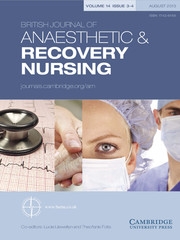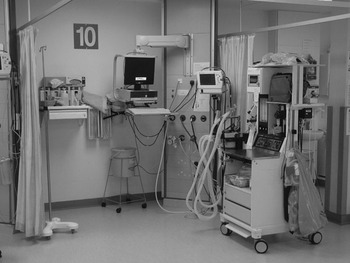
1. Describe the type of service you provide in your Anaesthetic/Recovery Room?
We provide post-operative care for general surgery, day surgery and long-term patients including high dependency. We also take urology, gynaecology, elective orthopaedic cases and orthopaedic surgery admitted as emergency trauma cases. Obstetric surgery including numerous emergency caesarean sections and elective cases come through this unit and our emergency surgery can cover any speciality. We also care for the intubated paediatric patient awaiting transfer to a Paediatric Hospital. Our recovery carries the emergency bleep to attend all cardiac arrest cases in the hospital including trauma and paediatric emergencies in the A&E department.
2. How is your unit set up?
We have eleven bays, which include a high-dependency bay, and a paediatric bay at the end of recovery, where conscious children can be moved to. This area can be screened off completely to allow the parents to be with their child after surgery. There is no nurse’s station but an area where the drug cupboards are situated and paperwork is kept. When the department was designed, we were asked for our input and a decision was made not to have a nurse’s station. We felt this encouraged other members of staff from theatre to congregate, which could become distracting to the recovery nurses and their patients. We feel that this has been a very successful move.

3. Introduce us to your team.
We are an all-nurse-staffed theatre, so there is usually a senior band 6 nurse in charge (Sister) along with four to five other band 5 and 6 nurses. We have three escort nurses (a band 6 and two band 5 qualified nurses) to escort the patients back to the wards. However, children and obstetric cases are collected by their own nurses or midwives. There are three theatre support workers who help take patients to the wards and help us transfer patients in recovery to their beds.

4. What are the daily clinical or managerial challenges you cope with in your unit?
The most challenging part of the day is managing the unit when it is very busy, as it is usual for many of the theatres to finish at the same time. We also have to deal with a shortage of staff due to sickness. If at a busy time there are high-dependency patients, i.e. unstable or in extreme pain, staffing can be problematic. However, we are lucky to have senior staff that will help when the situation arises.
5. What part of your working day do you find the most rewarding?
Knowing the unit has run smoothly and the patients returned to the ward comfortably. It is important to us that the patients are satisfied and involved with all aspects of their care. The teamwork amongst the staff ensures the best possible care is delivered to their patients and the staff feedback at our morning meeting reflects this.
6. How do you orientate learners to your unit and what provision do you have for ongoing education?
Our learners have an induction booklet, which is completed during their initial weeks, and when time allows. They are also encouraged to attend study days on relevant subjects in this area. On audit days we have in-house teaching and staff are also encouraged to attend any impromptu teaching that is happening in the department.
7. What was the last audit/research your unit took part in, and what were the outcomes?
An audit was undertaken by one of our nurses, which looked at the pre- and post-operative temperatures of patients undergoing minor gynaecological surgery. It was found that many of the patients had a low temperature prior to the surgery being carried out and it therefore became a practice to monitor the patient’s temperature throughout surgery.
As an outcome to this audit we are now looking to monitor patients’ temperatures pre-operatively before anaesthesia and warming those cases during surgery, however small, if the need arises.




